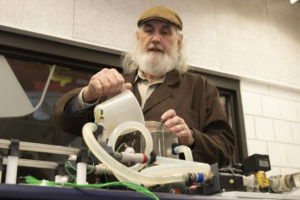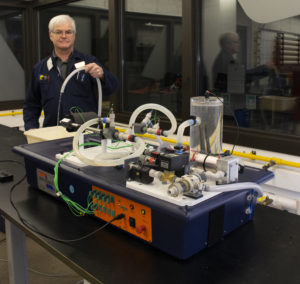Well before the COVID-19 pandemic vastly altered the everyday lives of people across the globe, a group of mechanical engineering (ME) faculty and staff at Iowa State University were working on ways to bring virtual, hands-on labs into the homes of students via the internet.

In 2012, Jonathan Wickert, then dean of Iowa State’s College of Engineering, provided a challenge and funding to the departments in the college through his Dean’s Education Initiative. Sriram Sundararajan, then an associate professor in ME, and Jim Dautremont, electronics technician for ME, responded to that challenge by developing ways to deliver thermo-fluids laboratory experiments remotely. In their initial study, the duo developed remote labs for three ME lab exercises: two in the fluids course (ME 335) covering pumps and linear momentum concepts and one exercise in the heat transfer (ME 436) course covering steady state conduction and extended surfaces. The researchers selected experiments that focused on data collection and analysis rather than an inquiry-based laboratory experience.
In each experiment, computer-based remote access was established to view and control the experimental apparatuses, which provided the students with a mechanism to conduct the experiments from a distant, online environment. This emphasis on online course delivery was aimed to address some of the issues the department faced in 2014, which included high enrollment and lack of available teaching laboratory space. It was also aimed at meeting the needs of students who wanted to take classes while away from campus for internships, co-ops and study abroad opportunities. Additional rationale and guidance was later published in the Iowa Board of Regents’ Transparent, Inclusive Efficiency Review (TIER) e-Learning draft report.
When developing this new course delivery, the researchers wanted to ensure that students studying remotely would receive the same quality of education as those studying on campus.

“More than ‘maintain’ quality, we focused on ensuring a comparable experience for labs,” said Sundararajan who currently serves as Associate Dean for Academic Affairs in the College of Engineering as well as a professor of ME. “This included remote control of experiments, clear visual aids and live data, same group size and TA [teaching assistant] support for the two cohorts: in lab and out of lab.”
In the study, the students were divided into two groups: one group performed the lab as usual, the other group were removed to another room to conduct the experiment. Students in the remote lab reported a similar learning experience compared to their peers in the physical lab.
“These techniques and approaches provide a viable pathway to provide laboratory-based experiences to students in an online or virtual environment. This approach is conducive for labs where acquisition and analysis of real data is the focus rather than open-ended design-build experiences,” Sundararajan said.

John Howell, teaching laboratory coordinator for ME, joined the effort in July 2014, taking over responsibilities in the fluids and heat transfer courses and bringing in his expertise in systems engineering. In the intervening years, further laboratory equipment purchases and laboratory development were made, keeping in mind the possibility of remote data acquisition and control.
The team officially launched their first live, fully remote lab exercise as part of the heat exchanger lesson for ME 436: Heat Transfer on April 14, 2020. Earlier in the spring 2020 semester, courses were moved online to combat the spread of COVID-19. So, remoting proved to be the only way to bring an interactive laboratory experience into the homes of the students studying off-campus. The exercise allowed lab groups to remote in. Students used a web browser to run a National Instruments, LabVIEW program as well as WebEx Teams to communicate with one another and their TA. ME senior Sarah Leahy serves as a lab technician for ME 436 and was available to answer technical questions about the apparatus.
Moving forward, online delivery of courses will continue to grow in popularity, so these ME researchers will continue to develop their technology to make this a more viable option to educate students. Eventually, they hope to fully automate the lab equipment to give the students working remotely the same visuals and sounds they would experience if taking the class in-person.
“The immediate challenge is to upgrade the remaining few labs in these courses to enable online content,” Dautremont said. “We want to get feedback from students to remove roadblocks and improve content delivery. Thought could be given to labs in other courses, too.”
Dautremont added that efforts, such as this, advance Iowa State’s mission as a land grant university by educating those in remote areas of the state, and beyond.
“We’d like to challenge the university to continue in its land grant mission by offering degrees to those who are unable to come to campus to take courses. The challenge goes beyond providing technical content to supporting these students in their communities as we do for students on campus.”
